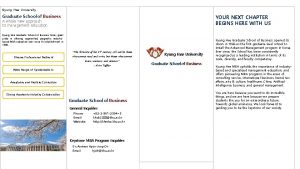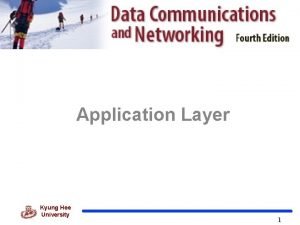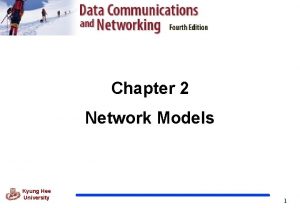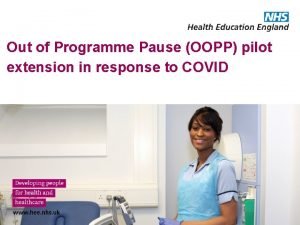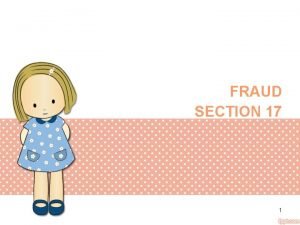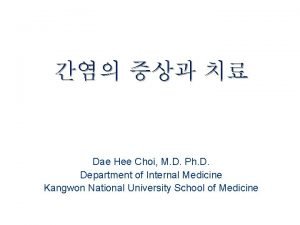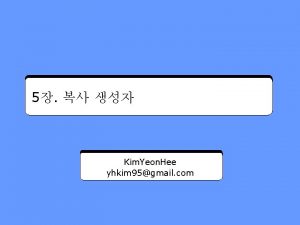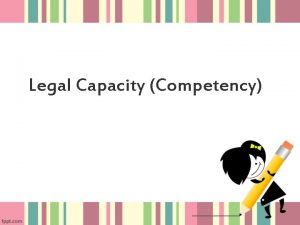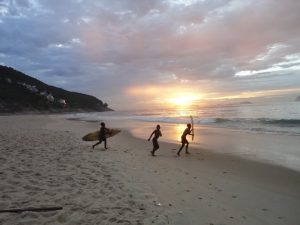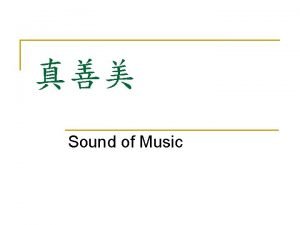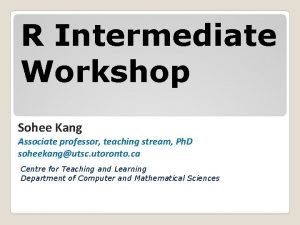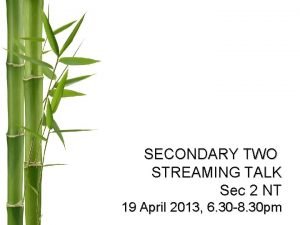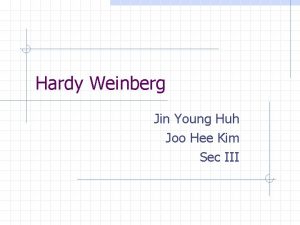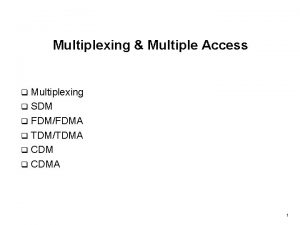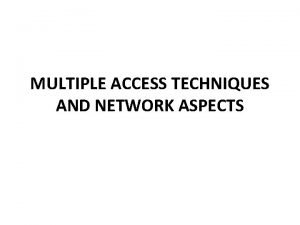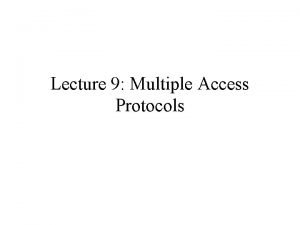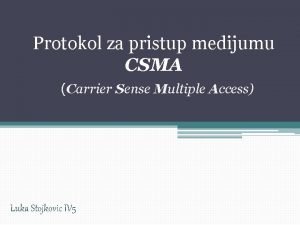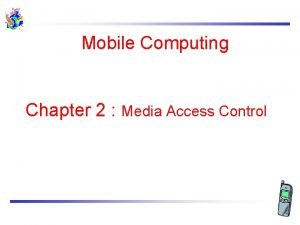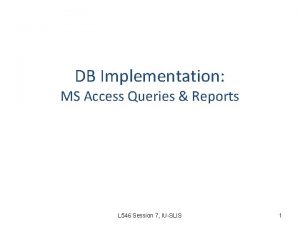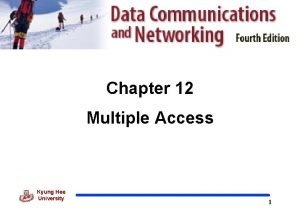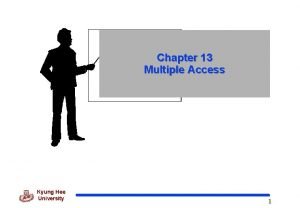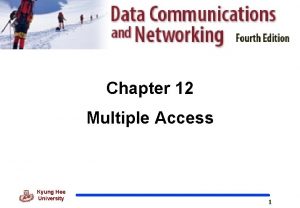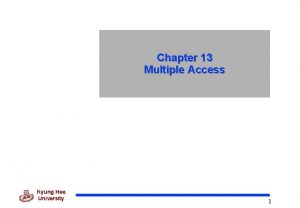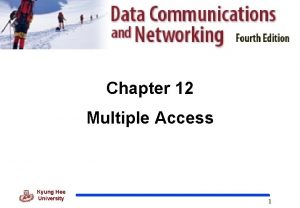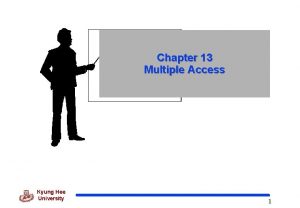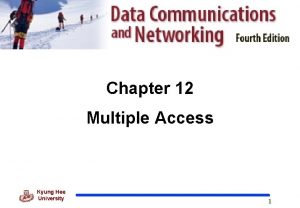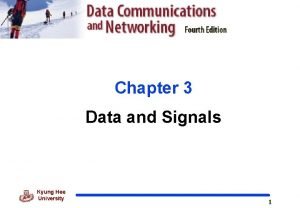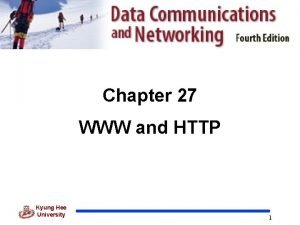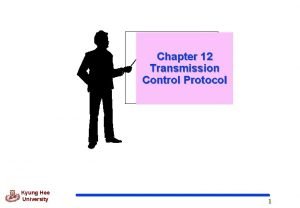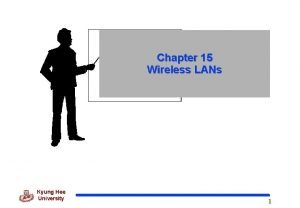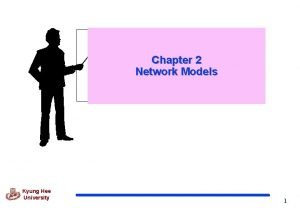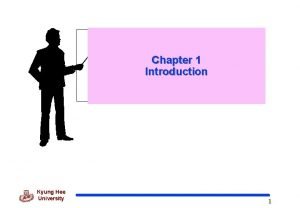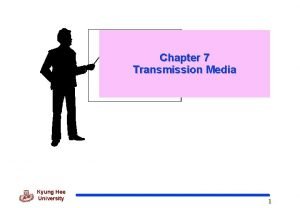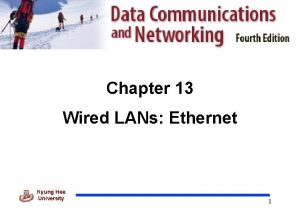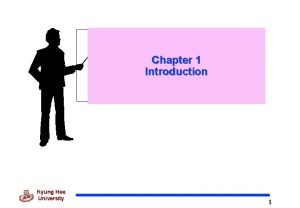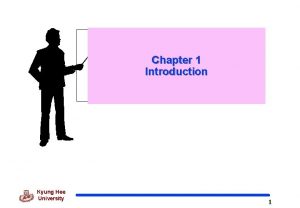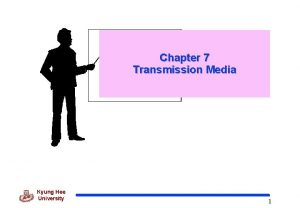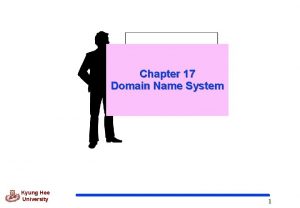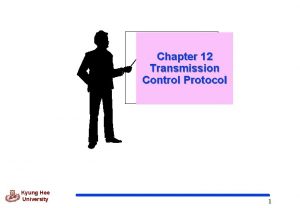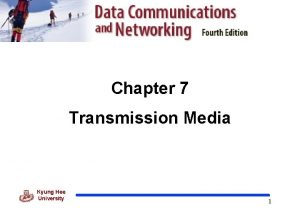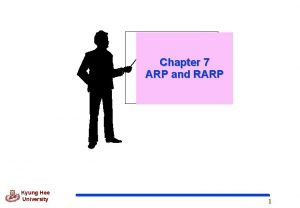Chapter 13 Multiple Access Kyung Hee University 1





























- Slides: 29

Chapter 13 Multiple Access Kyung Hee University 1

13. 1 Random Access q MA – Multiple Access q CSMA – Carrier Sense MA q CSMA/CD – CSMA/Collision Detection q CSMA/CA – CSMA/Collision Avoidance Kyung Hee University 2

Evolution of random-access methods Kyung Hee University 3

ALOHA network – Multiple Access • Base station is central controller • Base station acts as a hop • Potential collisions, all incoming data is @ 407 MHz Kyung Hee University 4

Procedure for ALOHA protocol Kyung Hee University 5

Collision in CSMA – Carrier Sense MA Kyung Hee University 6

Persistence strategies A random period of time q 1 - persistent q p-persistent Kyung Hee University 7

CSMA/CD procedure – Collision Detection - Used in Ethernet Usually 15 In the exponential backoff method, backoff time : between 0 and 2 N x (maximum propagation time) Kyung Hee University 8

CSMA/CA procedure – Collision Avoidance - Used in Wireless LAN Interframe Gap Kyung Hee University 9

13. 2 Controlled Access • Stations consult one another to find which station has the right to send Reservation Polling – Select and Poll Token Passing Kyung Hee University 10

Reservation access method • A station need to make a reservation before sending data Kyung Hee University 11

Polling q If the primary wants to receive data, it asks the secondaries if they have anything to send. q The secondaries are not allowed to transmit data unless asked Kyung Hee University 12

Select Kyung Hee University 13

poll Kyung Hee University 14

Token-passing network q A station is authorized to send data when it receives a special frame called a token Kyung Hee University 15

Token-passing procedure Kyung Hee University 16

13. 3 Channelization FDMA – Frequency Division TDMA – Time Division CDMA – Code Division Kyung Hee University 17

FDMA q The available bandwidth is shared by all stations. q The FDMA is a data link layer protocol that uses FDM at the physical layer In FDMA, the bandwidth is divided into channels. Kyung Hee University 18

TDMA q The entire bandwidth is just one channel. q Stations share the capacity of the channel in time In TDMA, the bandwidth is just one channel that is timeshared. Kyung Hee University 19

CDMA q Only one channel occupies the entire bandwidth of the link q All Stations can send data simultaneously; there is no time sharing. In CDMA, one channel carries all transmissions simultaneously. Kyung Hee University 20

Chip sequences – Four Stations q CDMA is based on coding theory q Each station is assigned a code, which is a sequence of numbers called chips. q All Stations can send data simultaneously; there is no time sharing. Kyung Hee University 21

Encoding Rules q When a station is idle, it sends no signal, which is represented by a 0. Kyung Hee University 22

Encoding Rules q Showing how four stations share the link during 1 -bit interval. q CDMA Multiplexer Kyung Hee University 23

Encoding Rules q CDMA Demultiplexer Kyung Hee University 24

Sequence Generation q To generate sequences, we use a Walsh table, a twodimensional table with an equal number of rows and columns. q Each row is a sequence of chips Kyung Hee University 25

Sequence Generation Kyung Hee University 26

Properties of Orthogonal Sequences 1. If we multiply a sequence by -1, every element in the sequence is complemented 2. If we multiply two sequences, element by element and add the result, we get a number called the inner product. If two sequences are the same, we get N, where N is the number of sequences; if different , we get 0. So, A·A is N, but A·B is 0. 3. Inner product of a sequence by its complement is –N. So A·(-A) is –N. Kyung Hee University 27

Example 1 Check to see if the second property about orthogonal codes holds for our CDMA example. Solution The inner product of each code by itself is N. This is shown for code C; you can prove for yourself that it holds true for the other codes. C. C = [+1, -1, -1] = 1 + 1 + 1 = 4 If two sequences are different, the inner product is 0. B. C = [+1, -1, +1, -1]. [+1, -1, -1] = 1 - 1 + 1 = 0 Kyung Hee University 28

Example 2 Check to see if the third property about orthogonal codes holds for our CDMA example. Solution The inner product of each code by its complement is -N. This is shown for code C; you can prove for yourself that it holds true for the other codes. C. (-C ) = [+1, -1, -1]. [-1, +1, +1] = - 1 - 1 = -4 The inner product of a code with the complement of another code is 0. B. (-C ) = [+1, -1, +1, -1]. [-1, +1, +1] = -1 + 1 - 1 = 0 Kyung Hee University 29
 Kyung hee university mba
Kyung hee university mba Kyung hee university hospital at gangdong
Kyung hee university hospital at gangdong Kyung hee university uniform
Kyung hee university uniform Address cont'd
Address cont'd Captain kyung
Captain kyung Baseline
Baseline Multiple instruction single data
Multiple instruction single data Out of programme pause hee
Out of programme pause hee Tan hee juan v the boon keat
Tan hee juan v the boon keat Horus eportfolio
Horus eportfolio Horus.hee
Horus.hee Fraud section 17
Fraud section 17 D
D Yhkim
Yhkim Hee chang trading co ltd
Hee chang trading co ltd Tan hee juan case
Tan hee juan case Hee joo lee
Hee joo lee Https://www.youtube.comwatch
Https://www.youtube.comwatch So-hee kang utsc
So-hee kang utsc Cheong hee kiat
Cheong hee kiat Horus eportfolio
Horus eportfolio Seet tiat hee
Seet tiat hee Joo hee jin
Joo hee jin Difference between multiplexing and multiple access
Difference between multiplexing and multiple access Difference between multiplexing and multiple access
Difference between multiplexing and multiple access Multiple access techniques in mobile computing
Multiple access techniques in mobile computing Determine the taxonomy of multiple access protocols
Determine the taxonomy of multiple access protocols Csma cd
Csma cd Classical aloha in mobile computing
Classical aloha in mobile computing Access crosstab query multiple column headings
Access crosstab query multiple column headings
